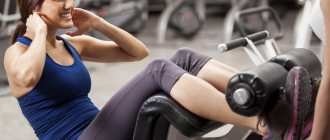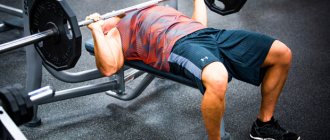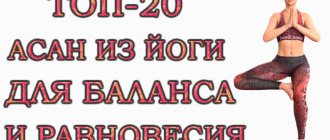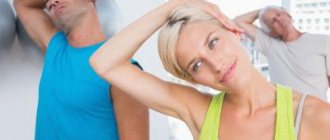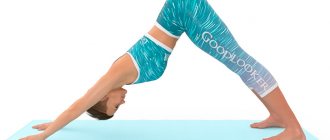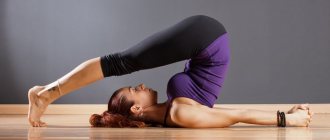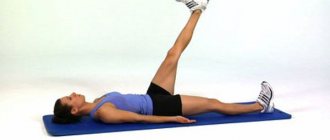In this article I will show a step-by-step set of yoga poses for beginners with descriptions and pictures.
The complex includes the most effective and simple asanas that will immediately bring you tangible results: improved health, inner peace, flexibility and body strength.
In yoga, not only the poses themselves are important, but also their sequence, including the alternation of different types of asanas: stretching, balances, inverted poses, twists.
The full set of yoga poses should be harmonious and complete, then the benefits of the classes will increase significantly.
Let's take a look at the basic yoga poses for beginners that anyone can do at home every day.
Yoga Poses for Beginners with Pictures
Starting out is never easy. But personally, my first yoga class was enough for me to continue practicing regularly for many years. Every yoga pose was difficult for me, but I made the decision not to give up.
Despite the fact that I could hardly balance between maintaining the pose and proper breathing, I felt that I liked this workout, because all the muscles worked, the whole body turned on, and after class in shavasana I was overcome by a wave of relaxation, like after a good massage.
Many people think that to practice yoga you need to be flexible, strong and have good balance. But in fact, these are all consequences of yoga practice, and not prerequisites. No one masters yoga poses on the first day. Yoga is the pursuit of empowering your body through regular and consistent practice. To do this you will need patience and discipline.
Don't forget to get your free online course on mindfulness meditation : get the course for free
There I show you the fastest and safest way to learn to meditate from scratch and bring a state of mindfulness into everyday life.
Sitting
menshealth.com
How to do it
A man sits on a bed or on a chair. The woman sits on top.
pros
The position is good for long sex and for female orgasm, since the partner can control the process. Additional advantages are the proximity of the partners, the comfort of the position itself and the ability to change the pace and angle of penetration.
Minuses
In the version with a chair, the position may be uncomfortable for a short partner.
Variation 1. Cradle
askmen.com
How to do it
Both partners sit on the bed, the woman wraps her legs around the man’s body.
Read also…. Features of men's skin care
pros
Even more sensuality and relaxation, partners can rock together, slowly reaching orgasm.
Minuses
Lack of depth and dynamics.
Variation 2. Woman lying down
askmen.com
How to do it
Another intermediate option between the missionary position and doggy style. This time the woman lies on her back and the man sits on his knees.
pros
Both partners can control the speed and depth of penetration. A man can additionally caress his partner’s breasts and clitoris.
Variation 3. Sitting + standing
menshealth.com
How to do it
There are almost no standing positions in the selection, because they, as a rule, are not very comfortable and require increased strength from a man. But this variation simplifies the situation: a man does not need to hold a woman up; it is enough to sit her on a table or other surface suitable for his height.
pros
Deep penetration and variety that this position brings to the sexual life of partners.
Minuses
With all the modifications, the position is still not comfortable enough. If your partner doesn't like to stand during sex, it won't be suitable.
Tips for beginners to master yoga asanas at home
For those starting to learn yoga poses on their own at home, it will be useful to learn a few basic principles of practice:
• If you have a medical condition or injury, consult your physician before subjecting your body to any physical activity. • Do poses that you can do comfortably. There is no competition in yoga, listen to your body and don’t put pressure on yourself. • The many benefits of yoga practice will unfold gradually. Be regular in your practice and don't give up because you can't touch your toes on the first day. • Don't be discouraged if you lack flexibility and dexterity, everything will come with practice. • Learn to focus on your breathing from the very beginning. • Understand that every body is unique. Everyone has different levels of strength, flexibility and endurance. Everyone also has different lifestyles and goals. Find a yoga style that suits your needs.
How to have sex to conceive a baby
To conceive a child, it is not enough to eliminate the use of contraceptives. This process requires proper preparation. Before planning a pregnancy you must:
- take a course of vitamins;
- undergo a medical examination (take tests, and, if necessary, be treated for sexually transmitted infections);
- stop taking medications that are used regularly;
- establish the correct sleep and wakefulness schedule;
- adjust your diet (exclude fast food, alcohol, large amounts of sweets);
- quit smoking.
Not only women, but also men need to be attentive to their health. An unhealthy lifestyle affects the quality of a man’s semen and the ability to fertilize an egg.
Adjustments should also be made to the intimate plan:
- You need to have sex more regularly, and foreplay should last longer. This will increase the amount of lubrication, which will have a beneficial effect on the movement of sperm.
- Sex should always end missionary style. For the best effect at the end of the act, a woman needs to make a “birch tree” or “candle”. Correct execution will prevent sperm from leaking out of the womb.
Read also…. How to masturbate properly for girls
If pregnancy does not occur for several years, you should consult a doctor. He will conduct additional examinations and prescribe medications to stimulate ovulation.
Proper sex is not a myth, but a reality. Everyone is capable of pleasing their other half. It is important not to give up if you fail. Frank heart-to-heart conversations, experiments and love will definitely help you achieve a cosmic orgasm.
Different yoga poses and their effect on the body
Yoga poses provide much more benefits than just increasing physical strength and flexibility.
Studies show that short 20-minute yoga sessions improve brain function and concentration. Different types of asanas have different effects on the body.
Straight curves of the back increase the activity of the nervous system, and rounding of the back has a calming effect.
Static poses develop endurance, and balances improve concentration.
The twists help the body rid itself of toxins and cleanse the internal organs through a gentle massage.
If you are new to yoga, start with simple asanas, which I will discuss below.
Hold each asana for 3-5 long, calm breaths. Start by practicing 2 times a week and gradually yoga will become a part of your life. Also, do not forget that yoga is not only asanas; for example, in kundalini yoga , kriyas are more often practiced, that is, active rhythmic movements.
A little more about the benefits of statics
The enormous importance of static gymnastics was spoken about at the beginning of the 20th century by “Iron Samson,” or rather, Alexander Zass, a domestic classic of bodybuilding and the founder of isometric gymnastics. According to him, it is better to have strong arms than big muscles. He drew the attention of athletes to the fact that often, in a reckless desire to acquire powerful biceps, athletes lost control over them. That is, in essence, the muscular relief became a useless landscape on the human body, which he was unable to use. Indeed, do we rarely see people with outwardly pumped up body parts, but unable to do even 5 pull-ups?
The fact is, as Alexander Zass taught, that it is not the muscles themselves that are responsible for the real strength of a person, or rather not their middle parts, but the tendons with which these muscles are attached to the bones . By the way, anatomically, any muscle consists of a central part (active) - the “abdomen”, and passive endings (tendons), with which it is attached to the bones on both sides.
So, it is the degree of development of the tendons that determines how fully a person can use the active part of the muscles, since they set the latter in motion.
Imagine an emaciated beast of burden harnessed to a railroad trailer. Will it be able to move it? The answer is obvious. Tendons are the motor force of your musculoskeletal system, and it was the need for their development that the great contemporary of our great-great-grandmothers spoke about.
In this article we are talking about static exercises performed at half strength, which develop red muscle fibers, facilitating weight loss and good blood supply to the muscles. In contrast, the isometric complex, following the example of Alexander Zass, affects white fibers, the percentage predominance of which is observed in sprinters and weightlifters. These fibers are also called “fast fibers” because of their ability to contract quickly, but they do not have long-term endurance. That's why sprinters run short distances!
Let's talk about red fibers. They are physiological antonyms of whites, which is why they are called “slow”, due to their inability to rapidly contract. But thanks to them, athletes achieve high levels of endurance. Practitioners of sports in which endurance is important have a predominant number of red muscle cells.
Basic yoga asanas for beginners at home
Mountain Pose - Tadasana
This pose teaches one to be as majestic and stable as a mountain.
The word "tada" means "mountain", hence the name.
This pose improves focus and concentration. This is the starting position for all other asanas.
Stand with your heels slightly apart and your arms hanging loosely at your sides. Feel the weight of your body, feel how your body weight presses on the floor and the floor supports you, trust the entire weight of your body to this support.
Reach the top of your head towards the sky. With each exhalation, relax your shoulders more and more.
Tree Pose - Vrikshasana
This pose provides a feeling of grounding, improves balance, and strengthens the legs and back.
This body position makes us feel our center of gravity and center line.
This, in turn, in addition to its beneficial effect on health, also develops the nervous system, which means it gradually changes the psyche, centering and balancing the mind.
The benefits of mastering this pose are endless.
Downward Facing Dog - Adha Mukha Svanasana
Perhaps the most famous yoga pose. Downward-facing dog pose provides the perfect balance of strength and flexibility. Most yoga classes involve performing this asana several times.
Therefore, it is important to know a few basic principles of downward-facing dog pose.
Start on all fours with your hands shoulder-width apart and slightly in front of your shoulders. Stand on your toes and lift your hips, straightening your legs. Push your pelvis up with your strong legs. Push the floor with your hands and pull your tailbone up, stretching your spine.
Relax your neck.
Take 3-4 deep breaths and return to the starting position.
Staff Pose - Chaturanga Dandasana
This asana is in many ways similar to the famous plank exercise.
The difficulty of the pose depends on the correct execution. It is easy to trick yourself into this asana and make it easier on yourself, but this approach will not be beneficial in the long run.
Start performing this asana from a normal position while lying down, and then slowly lower your body, bending your elbows.
Keep your elbows close to your torso.
The legs are strong and active, the stomach is toned, the abs are working. Do not raise your pelvis or arch your lower back, keeping your entire body as flat as a board.
Cobra Pose - Bhujangasana
This asana helps open the chest.
In the cobra pose, it is the arching in the thoracic region that is of great importance; it would be a mistake to bend only at the expense of the lower back. You can move your arms far forward, or you can place your palms under your shoulders.
Lower your shoulders away from your ears and pull your shoulder blades back.
You can do this asana without lifting your pelvis from the floor, but in any case you need to stretch your toes, keeping your legs strong.
Child's Pose Salamba Balanasana
A very pleasant relaxing pose.
This asana can be practiced periodically throughout the class to rest and relax.
In a kneeling position, bring your feet together and reach forward, resting on your hips. Stretch your arms forward and relax, breathing deeply and freely. Direct your attention to the area between the eyebrows.
Shoemaker Pose - Baddha Konasana
In this asana we use gravity to open the hip joints.
Sit up straight, bring the soles of your feet together and bring your heels as close to your perineum as possible.
Breathe deeply and calmly, with each exhalation relaxing the muscles in the pelvic area more and more and releasing tension.
Lying Twist Pose - Supta Matsyendrasana
Twisting is an ideal way to give a gentle massage to the internal organs and help them free themselves from toxins and waste.
Lie on your back, bend your knees. Stretch your arms to the sides. As you exhale, lower your knees to one side. And turn your head in the other direction. This way you twist your body as if you were wrung out a towel. You can help lower your knees with one hand.
Half Pose of the King of Pisces - Ardha Matsyendrasana
If you feel like you need a deeper twist, this pose is for you. This asana is named after the lord of fish - Matsyendra. This pose allows you to twist your spine as deeply as possible.
While sitting, bend your right leg and place your heel under your crotch. Place your bent left leg on the outside of your right thigh. Turn your body to the left, place your left hand behind your back, and push off your left hip with your right elbow, thus twisting your spine.
Take 5 calm breaths and then repeat the asana in the other direction.
Bridge Pose - Setu Bandha Sarvangasana
You have probably seen this pose in various images as it is very popular in yoga.
Lie on your back and bend your knees.
Place your feet hip-width apart. Grasp your ankles with your hands and lift your pelvis up. Stay in the top position. You can support your body in the lumbar region with your hands or place them on the floor with your fingers crossed.
Don't tuck your chin to your chest, leaving some space and elongating your neck.
Crescent Moon Pose - Anjaneyasana
This pose stretches and strengthens the leg muscles. Start in Mountain Pose and then take a long step forward with your right foot into a wide stance. It is important that the right knee does not go beyond the right foot, that is, the angle at the knee is either straight or obtuse.
Make the back left leg strong, tighten the muscles so that the leg is taut like a string.
Extend both arms overhead and relax the entire upper body, leaving the minimum amount of tension necessary to maintain the asana.
Be sure to repeat the asana, changing legs.
Right side angle - Utthita Parsvakonasana
Right side angle pose opens the inner thighs and stretches the shoulder girdle.
Stand in a wide stance with your left leg back. Bend your right leg so that your knee is at a right angle. Make sure that your knee does not go beyond the line of your foot.
Stretch your back left leg like a string. Bend sideways toward your right hip, extending your left arm overhead and stretching the entire left side of your body.
You can lean on the floor with your right hand.
Warrior Pose 2 – Virabhadrasana 2
A good asana for building strength and flexibility. This pose opens the inner thighs.
While standing, take one leg back and bend your front leg at a 90-degree angle.
Turn your front foot forward and turn your back foot to the side.
Extend your arms wide in a T shape so that your hips and shoulders are open.
Repeat on the other side.
Triangle Pose – Trikonasana
This pose also applies to standing asanas.
From a standing position, take one leg back. Turn your front foot forward and place your back foot at a 90-degree angle to your front.
Stretch your arms wide out to the sides in a T shape and then bend sideways toward your front leg, stretching the entire side of your body.
Place one hand on your front foot or on your shin, and turn your head to look up at your other hand.
Repeat on the other side.
Cat Pose and Cow Pose – Marjaryasana
This asana consists of alternating two backbends.
Get on all fours and, while inhaling, bend your back down, raising your head and thoroughly stretching your spine.
As you exhale, arch your back upward, stretching like a cat and stretching all your back muscles.
Thus, alternate these 2 deflections.
Stretch pose - Uttanasana
The name of this asana can be literally translated as “slow stretching of the spine.”
Get into mountain pose with your knees pulled up. As you exhale, slowly bend forward, touching your toes with your hands.
Don't bend your knees.
If stretching allows, place your palms on the floor on either side of your feet.
Ideally, you should hang your upper body completely and rest your head on your knees, relaxing in this position.
Stay in this position for 3-4 deep breaths.
Warrior Pose 1 – Virabhadrasana 1
Warrior Pose 1 is an ideal asana to compensate for a sedentary lifestyle.
It relieves tension in the hips and lower back, stretches the hamstrings and glutes.
Stand in a wide stance, pointing your right foot forward and turning your left foot at a 45-degree angle.
Turn your entire body towards your right leg and bend your right leg to a right angle at the knee.
The back left leg is taut like a string.
Raise your arms above your head and clasp your palms together. Stretch up at the same time as you slightly arch your back, and look to the sky.
Plank – Phalakasana
Plank pose is more than just a physical exercise.
It develops concentration and balances the psyche.
Stand with emphasis on your hands and balls of your feet. Press your hands to your body. Activate your abdominal muscles and buttocks, tighten your leg muscles so as not to sag down and lift your pelvis up.
Your whole body should be as smooth as a board.
Breathe deeply and calmly for several breaths.
Intense Lateral Extension Pose - Parsvottanasana
Test your stability and develop flexibility in this challenging but extremely rewarding pose.
Stand straight with one leg forward.
Turn both feet forward.
Bend over your front leg, trying to touch your forehead to your knee.
For a more intense stretch, place your palms together behind your back. If this is difficult, just lower your hands to the floor.
Try to lengthen your spine and open your chest without rounding your back too much.
Happy Child's Pose - Ananda Balasana
This is a fun pose, as its name suggests.
Staying in this asana brings only pleasure. Your body will thank you for this practice.
Lie on your back and bring both knees to your chest. Grasp the outer edges of your feet with your hands. Bend your knees 90 degrees.
Continue to pull your knees further to the sides of your body while rocking to relax your hips.
Garland Pose – Malasana
This asana is a low squat.
This position may seem uncomfortable at first, but you will quickly realize that it is a good way to stretch your hips and release tightness in the hip joints.
Stand with your feet shoulder-width apart, toes pointing slightly to the sides.
Slowly squat down, fold your hands with your palms in front of your chest, and rest your elbows on your hips, pushing them apart.
Chair Pose – Utkatasana
An excellent pose to strengthen the muscles of the lower back, abs and legs.
Start in a standing position with your feet together and knees connected. Stretch your arms up, clasp your palms together. In this position, bend your knees to a right angle.
At the same time, tuck your tailbone under you without protruding your pelvis. Try to press your navel to your spine, drawing in your stomach.
Bend head to knee - Janu Sirsasana
This asana combines bending stretching and body twisting.
Sit with your right leg straight and the heel of your left leg pulled towards your perineum.
Turn your torso towards your right leg and bend deeply, trying to touch either right knee.
At the same time, stretch forward with the top of your head and keep your back straight without hunching.
With each exhalation, release tension in the back of your right thigh.
Repeat on the other side.
Upward Facing Dog - Urdhva Mukha Svanasana
Just like downward-facing dog, this asana is usually performed several times during a yoga class.
This asana makes the spine flexible, improves posture, strengthens the back and legs.
Start by lying on your stomach, pointing your toes out and placing your palms under your shoulders.
Press your arms to your body and straighten, lifting your body up with a arch in your back.
Lower your shoulders away from your ears and push your shoulder blades back, opening your chest. Stretch the top of your head and your toes at the same time, stretching your entire body.
Stay in this position for a few breaths, then return to the starting position.
Seated Forward Bend – Paschimotanasana
In this pose, you should be careful and not make it easier for yourself by performing it incorrectly. It is important to bend forward by rotating your pelvis, not by bending your back.
You need to keep your back straight. This asana stretches the hamstrings and hamstrings.
Sit with your back straight and extend both legs forward. By rotating your pelvis, tilt your body forward, trying to touch your forehead to your knees. Hold your feet with your hands and stay in this position for several breaths.
In the beginning, you can use a belt to keep your back straight.
Pigeon Pose - Kapotasana
Many people lead a sedentary lifestyle. Chronic sitting causes the front of the thigh to shorten and weaken. Therefore, it is very important to stretch, load and engage this part of the body at least once a day.
Pigeon asana is an excellent exercise for this purpose.
Get on your knees and carefully bend back, leaning on your hands. Gradually bend your arms and lean on your forearms, grasping your feet.
Stay in this position for several breaths.
Extended Angle Pose – Upavishta Konasana
This pose stretches the inner thighs, hip joints, and muscles in the pelvic area.
Start in a sitting position with your legs straight out in front.
Then spread your legs wide apart.
Bend forward by rotating your pelvis, but not by bending your back.
Try to keep your back straight.
Crescent Moon Pose - Anjaneyasana
This pose deeply activates the hip flexors and strengthens the legs.
Start in Mountain Pose, then lunge forward with your right leg. Lower your left knee to the floor while bending your right leg. Stretch your arms up and cross your fingers.
In this position, pull your pelvis down more and more, relaxing and stretching your thigh muscles and hip joints.
Stretching pose - Ardha Uttanasana
This is an ideal asana to improve your posture. The key point in this asana is to stretch the spine; for this you need to keep your back straight, that is, lean forward by rotating your pelvis.
Stand straight with your feet together.
Rotate your pelvis and lean forward, keeping your back straight. Grasp your ankles with your hands and reach towards your knees. Contact your stomach with your thighs.
Hold this position for several breaths.
Corpse Pose – Savasana
This asana always ends any yoga session. It is needed for complete relaxation and awareness of all sensations in your body.
Despite the fact that this position seems to be the simplest, in fact, beginners are not always able to perform this asana correctly.
The thing is that many people do not know how to relax properly and continue to keep their body tense even just lying on their back.
Lie on your back, spread your legs and arms freely as you feel comfortable.
Try to relax your whole body, not forgetting the muscles of your face, neck, eyes, and lower back.
Keep all your attention on the sensations in your body, relaxing more and more.
Try not to get lost in thoughts and fall asleep.
